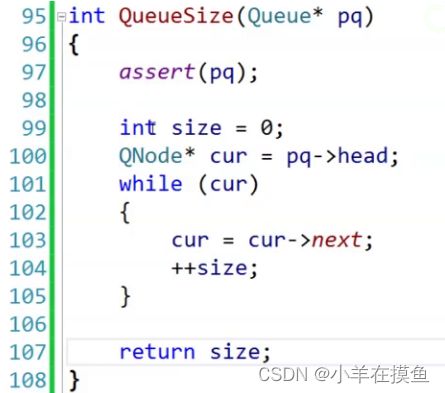数据结构_第七关:栈和队列(队列)
1.队列
1.1队列的概念及结构
- 队列:只允许在一端进行插入数据操作,在另一端进行删除数据操作的特殊线性表
- 队列具有先进先出FIFO(First In First Out)
- 入队列:进行插入操作的一端称为队尾
- 出队列:进行删除操作的一端称为队头
1.2队列的实现
队列也可以数组和链表的结构实现,使用链表的结构实现更优一些,
因为如果使用数组的结构,出队列在数组头上出数据,效率会比较低。
1)声明
#pragma once
#define _CRT_SECURE_NO_WARNINGS
#include
#include
#include
#include
typedef int QDataType;
typedef struct QueNode
{
QDataType data;
struct QueNode* next;
}QNode;
typedef struct Queue
{
QNode* head;
QNode* tail;
int size;
};
// 初始化队列
void QueueInit(Queue* pq);
// 销毁队列
void QueueDestroy(Queue* pq);
// 队尾入队列
void QueuePush(Queue* pq, QDataType x);
// 队头出队列
void QueuePop(Queue* pq);
// 获取队列头部元素
QDataType QueueFront(Queue* pq);
// 获取队列队尾元素
QDataType QueueBack(Queue* pq);
// 检测队列是否为空,如果为空返回非零结果,如果非空返回0
int QueueEmpty(Queue* pq);
// 获取队列中有效元素个数
int QueueSize(Queue* pq); 2)实现
初始化队列
void QueueInit(Queue* pq)
{
assert(pq);
pq->head = NULL;
pq->tail = NULL;
pq->size = 0;
}销毁队列
void QueueDestroy(Queue* pq)
{
assert(pq);
QNode* cur = pq->head;
while (cur)
{
QNode* del = cur;
cur = cur->next;
free(del);
}
pq->head = pq->tail = NULL;
pq->size = 0;
}队尾入队列
void QueuePush(Queue* pq, QDataType x)
{
assert(pq);
QNode* newnode = (QNode*)malloc(sizeof(QNode));
if (newnode == NULL)
{
perror("malloc fail");
exit(-1);
}
newnode->data = x;
newnode->next = NULL;
if (pq->tail == NULL)
{
pq->head = pq->tail = newnode;
}
else
{
pq->tail->next = newnode;
pq->tail = newnode;
}
pq->size++;
}这里,在在tail和head为NULL的插入,因为要改变结构体,一般需要用到双指针
但是也可以有其他办法,比如返回值,这里在说明第三种方法,就是用结构体
因为我们上面给head指针和tail真正封装到了结构体里面,所以这里可以直接改变
队头出队列
void QueuePop(Queue* pq)
{
assert(pq);
assert(!QueueEmpty(pq));
if (pq->head->next == NULL)
{
free(pq->head);
pq->head = pq->tail = NULL;
}
else
{
QNode* del = pq->head;
pq->head = pq->head->next;
free(del);
}
pq->size--;
}获取队列头部元素
QDataType QueueFront(Queue* pq)
{
assert(pq);
assert(!QueueEmpty(pq));
return pq->head->data;
}获取队列队尾元素
QDataType QueueBack(Queue* pq)
{
assert(pq);
assert(!QueueEmpty(pq));
return pq->tail->data;
}检测队列是否为空,如果为空返回非零结果,如果非空返回0
int QueueEmpty(Queue* pq)
{
assert(pq);
return pq->head == NULL && pq->tail == NULL;
}获取队列中有效元素个数
int QueueSize(Queue* pq)
{
assert(pq);
return pq->size;
}上面的方式是在Queue结构体中定义了size变量,如果没有size变量的话就如下面的样子
这种遍历的方法去记录size的时间复杂度比较大,为O(n),
2.源代码(VS2022下编写)
#pragma once
#define _CRT_SECURE_NO_WARNINGS
#include
#include
#include
#include
//声明:
typedef int QDataType;
typedef struct QueNode
{
QDataType data;
struct QueNode* next;
}QNode;
typedef struct Queue
{
QNode* head;
QNode* tail;
int size;
};
// 初始化队列
void QueueInit(Queue* pq);
// 销毁队列
void QueueDestroy(Queue* pq);
// 队尾入队列
void QueuePush(Queue* pq, QDataType x);
// 队头出队列
void QueuePop(Queue* pq);
// 获取队列头部元素
QDataType QueueFront(Queue* pq);
// 获取队列队尾元素
QDataType QueueBack(Queue* pq);
// 检测队列是否为空,如果为空返回非零结果,如果非空返回0
int QueueEmpty(Queue* pq);
// 获取队列中有效元素个数
int QueueSize(Queue* pq);
//定义
// 初始化队列
void QueueInit(Queue* pq)
{
assert(pq);
pq->head = NULL;
pq->tail = NULL;
pq->size = 0;
}
// 销毁队列
void QueueDestroy(Queue* pq)
{
assert(pq);
QNode* cur = pq->head;
while (cur)
{
QNode* del = cur;
cur = cur->next;
free(del);
}
pq->head = pq->tail = NULL;
pq->size = 0;
}
// 队尾入队列
void QueuePush(Queue* pq, QDataType x)
{
assert(pq);
QNode* newnode = (QNode*)malloc(sizeof(QNode));
if (newnode == NULL)
{
perror("malloc fail");
exit(-1);
}
newnode->data = x;
newnode->next = NULL;
if (pq->tail == NULL)
{
pq->head = pq->tail = newnode;
}
else
{
pq->tail->next = newnode;
pq->tail = newnode;
}
pq->size++;
}
// 队头出队列
void QueuePop(Queue* pq)
{
assert(pq);
assert(!QueueEmpty(pq));
if (pq->head->next == NULL)
{
free(pq->head);
pq->head = pq->tail = NULL;
}
else
{
QNode* del = pq->head;
pq->head = pq->head->next;
free(del);
}
pq->size--;
}
// 获取队列头部元素
QDataType QueueFront(Queue* pq)
{
assert(pq);
assert(!QueueEmpty(pq));
return pq->head->data;
}
// 获取队列队尾元素
QDataType QueueBack(Queue* pq)
{
assert(pq);
assert(!QueueEmpty(pq));
return pq->tail->data;
}
// 检测队列是否为空,如果为空返回非零结果,如果非空返回0
int QueueEmpty(Queue* pq)
{
assert(pq);
return pq->head == NULL && pq->tail == NULL;
}
// 获取队列中有效元素个数
int QueueSize(Queue* pq)
{
assert(pq);
return pq->size;
}
//测试:
void text1()
{
Queue q;
QueueInit(&q);
printf("入队列:1,2,6,9,8\n");
QueuePush(&q, 1);
QueuePush(&q, 2);
QueuePush(&q, 6);
QueuePush(&q, 9);
QueuePush(&q, 8);
printf("队头:%d \n", QueueFront(&q));
printf("队尾:%d \n", QueueBack(&q));
printf("出队列两次\n");
QueuePop(&q);
QueuePop(&q);
printf("队头:%d \n", QueueFront(&q));
printf("队尾:%d \n", QueueBack(&q));
printf("\n队列大小:%d\n", QueueSize(&q));
printf("\n队列是否为空:%d\n", QueueEmpty(&q));
printf("\n返回队头结点:%d\n", QueueFront(&q));
printf("\n返回队尾结点:%d\n", QueueBack(&q));
printf("\n打印队列:\n");
while (!QueueEmpty(&q))
{
printf("%d ", QueueFront(&q));
QueuePop(&q);
}
printf("\n");
QueueDestroy(&q);
}
int main()
{
text1();
return 0;
} 
